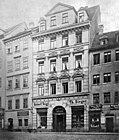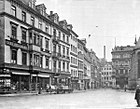Thomaskirchhof
The Thomaskirchhof is a square in the western old town of Leipzig. The Thomaskirche is at its center .
location
The Thomaskirchhof surrounds the Thomaskirche on three sides (north, east and south). On the outside of the square there are roads with the address Thomaskirchhof. In the west, the Dittrichring closes the square. The Klostergasse, Thomasgasse and Burgstraße open onto the Thomaskirchhof. The square has an extension of about 115 meters in an east-west direction and is about 90 meters wide on the west side. In the southeast corner, buildings extend into the square of the square. The resulting small, intimate part, about 23 by 36 meters with the New Bach Monument south of the church, is often mistakenly viewed as the entire Thomaskirchhof. In the northern part of the square, the entrance to the underground car park is under the market gallery .
History and development
After the foundation of the Leipzig Canons of the Augustinian Order with confirmation by Margrave Dietrich von Meißen in 1212, the previous market church became the collegiate church of St. Thomas and the surrounding area became the monastery grounds. As a result of the secularization of the Canons' Monastery in the course of the Reformation , the area around the Thomaskirche fell to the Saxon court, from which the city of Leipzig bought it and had the monastery buildings torn down in 1543 to obtain building land.
North side
The Leipzig merchant Heinrich Scherl (1475–1548) acquired the corner property Thomaskirchhof / Klostergasse from this building site and erected a four-story building. It was bought by the Elector August from the descendants of Scherl, who got into debt, in 1582 and combined it with the neighboring property acquired in 1559 to form the electoral office . The building, which existed until around 1900, also housed the Leipzig Drawing Academy , founded in 1764 , the Electoral Saxon or Royal Saxon post office and other facilities. After the post office and the administrative building had moved to Augustusplatz, the Reformed Church acquired the building and converted the prayer room in the courtyard into a church with a classical sermon hall in 1841 .
The neighboring building, the so-called Consistorium , also belonged to members of the Scherl family. It housed ecclesiastical administrative facilities before it moved into the Ratsfreischule from 1852 to 1871 . The municipal advanced training school for girls was then housed until it was demolished. The last buildings in the row were the sexton's house and the superintendent's office.
The latter reached up to the city wall, which was initially still closed there. At the beginning of the 19th century, however, an opening to the promenade was created here. At the turn of the 20th century, the entire northern development of the Thomaskirchhof was abandoned and three commercial buildings were built on three large plots (Thomaskirchhof 20-22), the front of which was clearly indented compared to the old development to gain traffic space. (From 1896 to 1951 the tram drove through the Thomaskirchhof.) In 1905 the architect Peter Dybwad built a new business building on the corner of Dittrichring for the Meyer & Co. bank . Today, the restaurant “Tresor” is located in the former premises. On the corner of Klostergasse in 1903/04 Franz Ebert built his architecturally elaborate clothing store (Architects Schmidt & Johlige ), which after some war damage had been repaired in 1945 became a general department store (from 1949 consumer store “Progress”) and in 1984 the fashion house “Topas”. Commerzbank acquired it in 1990 and had it extensively refurbished as its Leipzig headquarters by 1994. The rich gold jewelry is unique for a commercial building in central Germany. The architect A. Conrad built another commercial building between the two corner properties in 1903.
East Side
After the confluence of the previously much narrower Thomasgasse coming from the market , a row of eight commercial buildings followed on the east side of the square. One of them was Gustav Steckner's department store on Petersstrasse , which extended to the Thomaskirchhof. It was designed by Otto Jummel in 1875 and contained one of the city's earliest shopping arcades, the Steckner-Passage between Petersstraße and Thomaskirchhof. Further south there was still a passage from the Thomaskirchhof to Petersstraße until the beginning of the 20th century. The first six houses in the row were destroyed in World War II and never rebuilt. In its place there is now the green area called Thomaswiese between Markt and Thomaskirche, which opens up the view from the old town hall to the Thomaskirche. The adjoining restaurant “Brauerei an der Thomaskirche” has the address Thomaskirchhof 3–5.
To the south, the east side of the Thomaskirchhof ended in a short cul-de-sac that is still there today. It has always been unofficially called "The Sack" and contains the properties with the numbers 7 to 11. This is where the service yard of the St. Thomas Monastery used to be. At the far end, which is now a commercial building built until 2005, was the “Thomas-Kloster” restaurant. Café Kandler forms the front right end of the sack. The neighboring house, the house of the church by the architect Peter Dybwad from 1911, does not belong to the Thomaskirchhof, but to the Burgstrasse which joins here and was built on the site of three previous preachers' houses that belonged to the Thomaskirche.
South side
The development of the south side of the Thomaskirchhof begins with the corner house no. 12, in which today the restaurant "Bachstüb'l" and the 1999 opened "Saxon Pharmacy Museum " with the restaurant "Centralapotheke" are located. Until 1996 as the "Central Pharmacy", the house is closely linked to the name of Willmar Schwabe and homeopathy . In 1863, Schwabe took over the management of the "Homeopathic Central-Apotheke Täschner & Co." located in the building for two years and bought the building, which is still owned by the family today. The 23-year-old Karl May lived in this house for a week in 1865 before his arrest for fraud.
After a narrow gap there is the house " Lindwurm ", whose name appeared as early as 1647 and refers to a wooden plaque with St. George killing the dragon that was attached until 1886 . It was rebuilt around 1900 and united with the neighboring house No. 14 during the last renovation in 2011. The ensemble now houses the Hotel "Bach14" and a wine restaurant.
House number 16 is the Bose House . The house, built in 1586, was bought by the gold and silver goods merchant Georg Heinrich Bose in 1710 and fundamentally rebuilt in a baroque style. Johann Sebastian Bach was a frequent guest in the Bose family. Today the house is a Bach memorial. It has housed the Bach Archive , founded in 1950, since 1985 , which is the basis for the Bach Museum, which is also located in the house . From 2008 to 2009 the building was renovated together with its neighboring house No. 15 and the Bach Museum was expanded and redesigned. The hall of the house was restored to its condition from 1711. From 1961 to 2007 the Bose House was also the venue for the Leipziger Pfeffermühle cabaret . The last house in the row belonging to the Thomaskirchhof is the residential and commercial building No. 17 with the restaurant "Johann S."; the corner house belongs to the Dittrichring.
West side
The west side south of the St. Thomas Church was the traditional location of the St. Thomas School . The collegiate school, operated by the monastery since the 13th century, became the property of the city in 1539, which it expanded in 1553 with an extension. The school formed the outer wall of the city. Beside her, which led Thomaspförtchen to Thomas mill and later on the promenade. In 1732, during Bach's tenure, the building was renovated in the Baroque style and heightened. Another renovation took place in 1829. In 1877 the school moved to a new building in Schreberstrasse due to a lack of space. The now vacant building at the Thomaskirchhof was demolished in 1899 for the construction of a new superintendent, whereby an important authentic place of brook maintenance was lost.
In the corner of the Thomaskirche and Superintendentur, the New Bach Monument has stood since 1908 in place of the Leibniz Monument that had been there since 1883 .
use
While the northern part of the Thomasfriedhof with the entrance to the underground car park is almost a pure traffic area, the southern part with the entrance to the St. Thomas Church, the Bach Monument, the Bach Museum and the St. Thomas Shop is one of the most important tourist spots in Leipzig. This is reflected not least in the high density of dining facilities. In the summer months the space is also used for open-air concerts.
The green space between Thomaskirchhof and Markt is a popular recreational area in the center of the city.
The Thomaskirchhof is part of the music-related parts of Leipzig's UNESCO World Heritage initiatives .
literature
- Dirk Scheidemantel: Leipzig, Thomaskirchhof - clergy, citizens and civil servants , State Office for Archeology Dresden 2012, Archaeonaut No. 2, ISBN 978-3-943770-02-5
- Wolfgang Hocquel: Leipzig. Architecture from the Romanesque to the present. Leipzig: Passage-Verlag 2001, ISBN 3-932900-54-5 , pp. 67-73
- Gabriel Calvo Lopez-Guerrero, Sabine Tzschaschel (ed.): ADAC travel guide Leipzig . ADAC Verlag, 2011, ISBN 3-899-05471-7 , p. 33 ff.
Web links
Individual evidence
- ↑ Thomasgasse in the Leipzig Lexicon
- ^ History of the Central Pharmacy
- ↑ Ernst Müller: The house names of old Leipzig . (Writings of the Association for the History of Leipzig, Volume 15). Leipzig 1931, reprint Ferdinand Hirt 1990, ISBN 3-7470-0001-0
Coordinates: 51 ° 20 ′ 22 ″ N , 12 ° 22 ′ 24 ″ E















